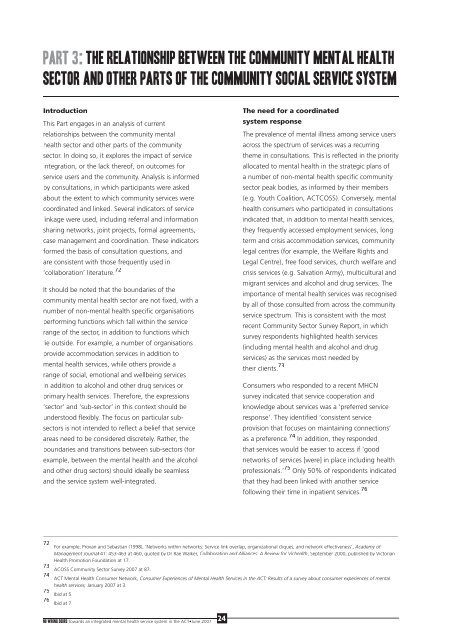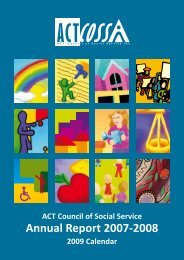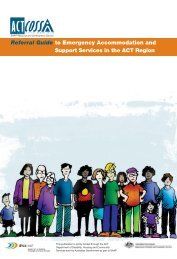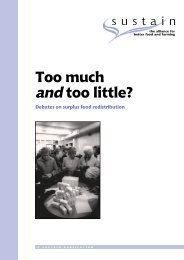actcoss text final.indd - ACT Council of Social Service
actcoss text final.indd - ACT Council of Social Service
actcoss text final.indd - ACT Council of Social Service
Create successful ePaper yourself
Turn your PDF publications into a flip-book with our unique Google optimized e-Paper software.
Part 3: The relationship between the community mental health<br />
sector and other parts <strong>of</strong> the community social service system<br />
Introduction<br />
This Part engages in an analysis <strong>of</strong> current<br />
relationships between the community mental<br />
health sector and other parts <strong>of</strong> the community<br />
sector. In doing so, it explores the impact <strong>of</strong> service<br />
integration, or the lack there<strong>of</strong>, on outcomes for<br />
service users and the community. Analysis is informed<br />
by consultations, in which participants were asked<br />
about the extent to which community services were<br />
coordinated and linked. Several indicators <strong>of</strong> service<br />
linkage were used, including referral and information<br />
sharing networks, joint projects, formal agreements,<br />
case management and coordination. These indicators<br />
formed the basis <strong>of</strong> consultation questions, and<br />
are consistent with those frequently used in<br />
‘collaboration’ literature. 72<br />
It should be noted that the boundaries <strong>of</strong> the<br />
community mental health sector are not fixed, with a<br />
number <strong>of</strong> non-mental health specific organisations<br />
performing functions which fall within the service<br />
range <strong>of</strong> the sector, in addition to functions which<br />
lie outside. For example, a number <strong>of</strong> organisations<br />
provide accommodation services in addition to<br />
mental health services, while others provide a<br />
range <strong>of</strong> social, emotional and wellbeing services<br />
in addition to alcohol and other drug services or<br />
primary health services. Therefore, the expressions<br />
‘sector’ and ‘sub-sector’ in this con<strong>text</strong> should be<br />
understood flexibly. The focus on particular subsectors<br />
is not intended to reflect a belief that service<br />
areas need to be considered discretely. Rather, the<br />
boundaries and transitions between sub-sectors (for<br />
example, between the mental health and the alcohol<br />
and other drug sectors) should ideally be seamless<br />
and the service system well-integrated.<br />
The need for a coordinated<br />
system response<br />
The prevalence <strong>of</strong> mental illness among service users<br />
across the spectrum <strong>of</strong> services was a recurring<br />
theme in consultations. This is reflected in the priority<br />
allocated to mental health in the strategic plans <strong>of</strong><br />
a number <strong>of</strong> non-mental health specific community<br />
sector peak bodies, as informed by their members<br />
(e.g. Youth Coalition, <strong>ACT</strong>COSS). Conversely, mental<br />
health consumers who participated in consultations<br />
indicated that, in addition to mental health services,<br />
they frequently accessed employment services, long<br />
term and crisis accommodation services, community<br />
legal centres (for example, the Welfare Rights and<br />
Legal Centre), free food services, church welfare and<br />
crisis services (e.g. Salvation Army), multicultural and<br />
migrant services and alcohol and drug services. The<br />
importance <strong>of</strong> mental health services was recognised<br />
by all <strong>of</strong> those consulted from across the community<br />
service spectrum. This is consistent with the most<br />
recent Community Sector Survey Report, in which<br />
survey respondents highlighted health services<br />
(including mental health and alcohol and drug<br />
services) as the services most needed by<br />
their clients. 73<br />
Consumers who responded to a recent MHCN<br />
survey indicated that service cooperation and<br />
knowledge about services was a ‘preferred service<br />
response’. They identified ‘consistent service<br />
provision that focuses on maintaining connections’<br />
as a preference. 74 In addition, they responded<br />
that services would be easier to access if ‘good<br />
networks <strong>of</strong> services [were] in place including health<br />
pr<strong>of</strong>essionals.’ 75 Only 50% <strong>of</strong> respondents indicated<br />
that they had been linked with another service<br />
following their time in inpatient services. 76<br />
___________________________________________________________________________________________________________________________<br />
72 For example, Provan and Sebastian (1998), ‘Networks within networks: <strong>Service</strong> link overlap, organizational cliques, and network effectiveness’, Academy <strong>of</strong><br />
Management Journal<br />
41: 453-463 at 460, quoted by Dr Rae Walker, Collaboration and Alliances: A Review for Vichealth, September 2000, published by Victorian<br />
Health Promotion Foundation at 17.<br />
73 ACOSS Community Sector Survey 2007 at 87.<br />
74 <strong>ACT</strong> Mental Health Consumer Network, Consumer Experiences <strong>of</strong> Mental Health <strong>Service</strong>s in the <strong>ACT</strong>: Results <strong>of</strong> a survey about consumer experiences <strong>of</strong> mental<br />
health services, January 2007 at 3.<br />
75 Ibid at 5.<br />
76 Ibid at 7.<br />
NO WRONG DOORS Towards an integrated mental health service system in the <strong>ACT</strong>•June 2007<br />
24













